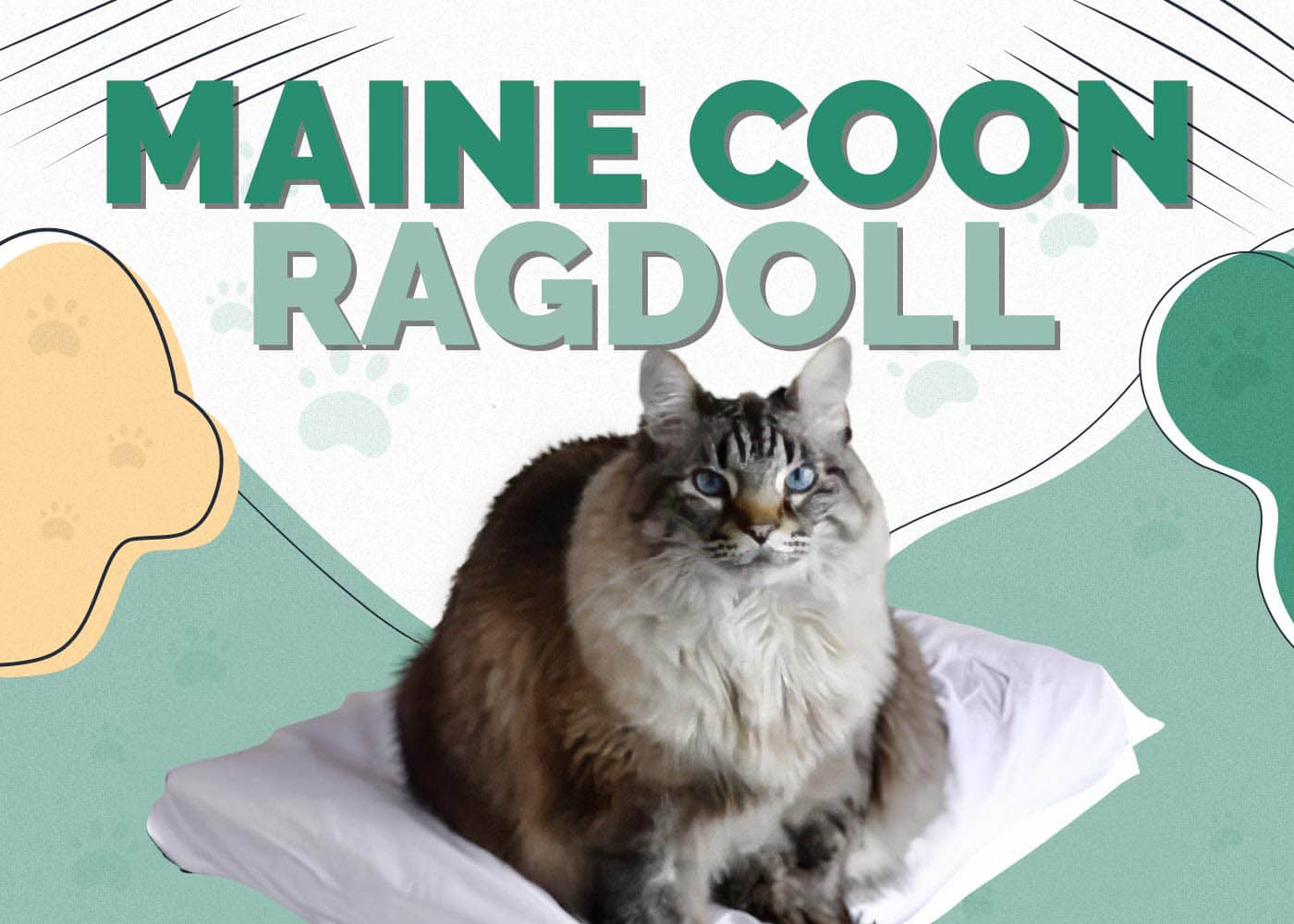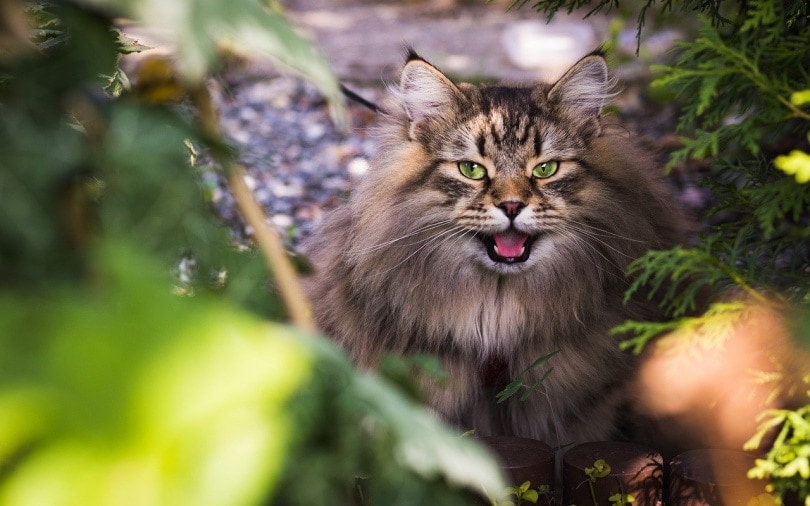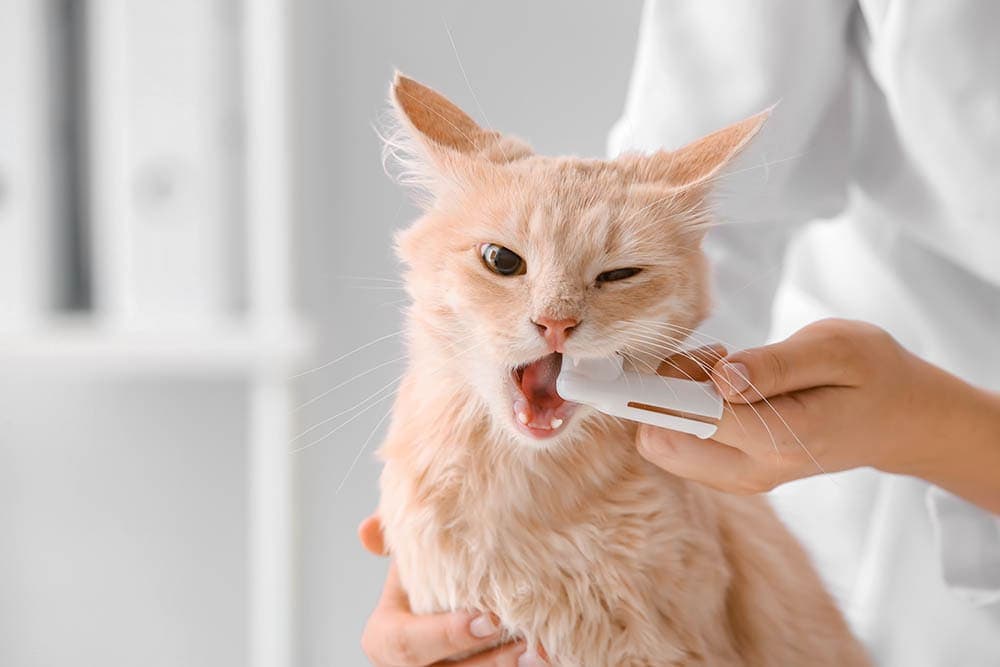Maine Coon Ragdoll: Info, Pictures, Characteristics & Facts
Updated on

Click to Skip Ahead
| Height: | 9 – 16 inches |
| Weight: | 15 – 20 pounds |
| Lifespan: | 12 – 15 years |
| Colors: | Nearly all colors |
| Suitable for: | Families and singles |
| Temperament: | Gentle, social, laidback |
The Maine Coon Ragdoll mix is a large and often affectionate breed. They are devoted to their people and often have above-average intelligence. Many are quite trainable and can be taught to walk on leashes and perform many tricks. They may or may not have significant hunting abilities, though.
Since this is a mixed breed, you can never be exactly sure what you’re going to get. Both the Maine Coon and Ragdoll are similar breeds, so their kittens tend to inherit many of the same traits. The gene pool isn’t as large as it might be for different mixed breeds. However, these cats will still vary more than purebreds.
In general, this mixed breed can be a great option for many families, as long as you’re willing to leave a few traits to chance. Their activity level can vary widely, while their level of cuddliness can range from being nearly obsessed with laps to being too busy to care.
Maine Coon Ragdoll Mix Kittens
The price of these cats can vary widely. This is largely because there are few established breeders, so it is often difficult for sellers to determine what the usual price is. Your local supply and demand often play a significant role. If there is only one breeder nearby who specializes in this mixed breed, then the price may be quite extensive.
While cats are usually cheaper if they are from unprofessional breeders and those with accidental litters, these kittens are usually lower quality. They’re cheaper for a reason. Professional breeders simply put more time and money into their kittens. For instance, many professional breeders genetically test their breeding cats to ensure that the kittens produced don’t inherit any genetic conditions. They also get plenty of vet care for their pregnant cats and kittens, which results in any health problems being treated early. Many also provide their cats with higher-quality food.
Overall, kittens from breeders are expensive up front, but they often cost you less in the long run. When you adopt from another source, you don’t exactly know what you’re getting. While rescues do get appropriate health care for their kittens, private sellers don’t always do this.
3 Little-Known Facts About the Maine Coon Ragdoll Mix
1. This mixed breed is often called the Ragcoon.
In many cases, this cat is referred to as the Ragcoon. If you’re having trouble finding litters, you may want to search for the breed under this name as well.
2. These cats may not actually “ragdoll.”
Ragdolls got their name from their tendency to droop when picked up. Because this breed is a mixed breed, they may or may not ragdoll. Many will ragdoll at least somewhat, but many may not do so enough to be noticeable.
3. This mixed breed is extremely smart.
The Maine Coon Ragdoll mix is easy to train, and most kittens from professional breeders are already litter trained by the time that they are available for adoption. They can be trained similarly to dogs, which includes walking on a leash.

Temperament & Intelligence of the Maine Coon Ragdoll Mix
These cats are large but extremely gentle. They are also laidback. However, they can be quite active. Often, they are fearless, which means that they often get along with other cats. Their dog-like personality often allows them to get along extremely well with canines.
It is common for these cats to be social, though they may be a bit unsure with strangers. The extent to which they’re friendly with strange people involves more of the socialization that they received when young rather than their particular personality traits. Usually, cats will follow their people around the house, but they aren’t so attached that they can’t spend time alone.
Often, these cats are not that aggressive. They’re confident and less likely to get scared due to their larger size. This limits the number of scratches and bites that other cats and human family members are subject to.
Usually, these cats are docile and laidback. They can be active or not active at all. It simply depends on the traits that they inherit. Some need regular exercise and playtime to stay happy and healthy, while others may be happier spending much of their time sleeping. Some love to be held, while others may never think about crawling into a lap.
It’s in their activity and affection level that these cats vary the most. Kittens often vary considerably even within the same litter, which is something that you need to keep in mind if you were hoping for a cat with a specific personality.
Are These Cats Good for Families? 👪
Yes, these cats tend to be great for families. They are often extremely sociable and love being around their people, though their main mode of interaction may differ. Their larger size makes them a good choice for children, though supervision is still required. Some may attempt to play and can even enjoy common “dog” games, like fetch. Others may rather crawl into a lap and lay there for a while. Most are somewhere in the middle.
Many of these cats are typically fine with children and adults of all dispositions and ages. Many aren’t even scared by active toddlers. As long as they can get somewhere high and escape if necessary, they typically do fine in a household with children of all sorts.
Of course, you should still prevent the child from injuring the cat. A few bad encounters can easily make these smart cats decide that they should steer clear of children.
Does This Breed Get Along With Other Pets?
This cat is known as the “gentle giant” because they get along so well with other pets. They are usually confident enough not to be scared of dogs, which makes them great in households with canines. This is especially true if they are around dogs from a young age. They will quickly learn that dogs aren’t something to be feared.
Of course, the exception to this is the cats that do learn to fear dogs. Since these cats are intelligent, they will change their behavior to match their past experiences. They aren’t solely reliant on their in-born predispositions. If a cat has a bad experience with a dog, they may learn to avoid dogs in the future. They may even become aggressive in some circumstances.
Usually, they get along quite well with other cats. Some may even be affectionate, depending on the cat’s disposition. These felines do well in multi-cat households, though they don’t necessarily need other cats to be happy and healthy.
Things to Know When Owning a Maine Coon Ragdoll Mix
Food & Diet Requirements 🐡
These cats don’t have any specific dietary needs in most cases. Certain animals may have health problems that must be counteracted by a change in diet. However, in most cases, you can feed your cats any high-quality commercial cat food.
Cats aren’t always able to consume enough moisture through a bowl of clean water alone, so it is often in your best interest to give them at least some wet food. This increases their moisture intake and can prevent urinary tract problems, which are quite common in cats. Two to three times a week is usually enough, but you may feed them more if you wish. Be sure to subtract their dry food on the days that they eat canned food, so you don’t feed them too many calories.
Since these cats are large, they often eat more than other cats. For this reason, you should plan on feeding them more than you expect. However, you should still pay attention to the weight recommendations on the back of the food, as these are essential for correctly feeding your cat. Free-feeding is not recommended, as this can lead to obesity.
Choose a food that is high in protein, as this is the major macronutrient that cats need to thrive. Their foods often contain mostly animal meat and similar ingredients and not so many veggies and grains.
Exercise 🐈
This cat’s exercise needs can vary widely. Some of them may prefer to spend most of their time lying around, while others will need serious exercise to stay healthy. In general, you can follow your cat’s lead in the amount of exercise that they need. Often, destructive behaviors can be the result of not enough exercise. If your cat tears things up or begins running around in the middle of the night, they probably need a bit more exercise throughout the day.
A lack of exercise can also lead to obesity. This can cause a serious problem for cats, leading to many different health problems and complications. Because these cats are so large, the extra weight can put an even more strain on their joints, causing arthritis and making their hip dysplasia more of a potential problem. If your cat is obese, you will also need to increase the amount of exercise that they receive.
Luckily, you can exercise these cats in many different ways. Many can be trained to walk on a leash, which allows them to get their exercise in a similar way to dogs. This is especially easy if you start them from a young age, which gives them plenty of time to get used to the situation.
Playtime is also a suitable option. Unlike dogs, many cats will easily get the amount of exercise that they require if you set up your home for plenty of jumping and climbing. Purchase many cat toys, and switch them out regularly so each toy is “new” when it appears again. Cat trees are also wonderful options because they provide plenty of room for your cat to run and jump.
Some of these felines particularly love to climb, so they may get into weird spaces in your house!
Training 🧶
These cats are extremely trainable. They learn quickly and are often people-oriented enough to actually listen to the commands. Most can be litter box trained from a young age, sometimes even before they are old enough to be adopted.
Both the Ragdoll and Maine Coon are intelligent, so there is going to be little variance between their kittens on this trait. Luckily, unlike dogs, you don’t necessarily have to provide these cats with mental stimulation, as long as they have plenty of toys and space to climb. They will often use their brain while “hunting” toys and climbing cat trees.
You can train these cats to do just about anything that you’d train a dog to do. They can easily learn to sit and lie down, as well as perform less practical tricks. Most will take quickly to walking on a leash as long as it is introduced slowly. They may feel odd walking in a harness at first, so it is important to provide them with plenty of harness time indoors before snapping on a leash and taking them outside. Slow and steady often wins the race. Unlike dogs, most cats are not overexcited to get outside.
Training cats is similar to training dogs. Positive reinforcement is key. If you use negative reinforcement (punishment), then your cat may simply stop interacting with the training sessions. Treats are an easy motivator, though some kittens are just as motivated by toys. One or two short training sessions a day are often all that these cats need. If they don’t walk on a leash yet, dedicate at least one of these sessions to leash familiarization.
Grooming ✂️
These cats will have long coats that will require care. You should brush them at least twice a week to prevent matting and remove dirt and debris. This also helps spread the natural oils in their coat, which can prevent breakage and keep the coat healthy.
These cats may shed particularly badly during certain parts of the year. This can vary from individual to individual and may be affected by your local climate, though. Therefore, we recommend paying attention to the amount that your cat is shedding. If brushing twice a week no longer seems like enough, you may want to increase it to every other day or even every day.
Like most cats, these felines do a good job of keeping themselves clean. They won’t need a bath often at all unless they get into something that is obviously not going to come out easily, like tree sap. Bathing at other times will not be necessary as long as you keep up with their grooming sessions, as these will much to keep the coat clean.
You should trim the fur on the bottom of your cat’s paws and potentially, their ears. This fur can cause problems for cats and can often be uncomfortable. Besides this, these cats do need regular trimming.
Start grooming your cat from an early age so they get used to it. Give them plenty of treats and praise when they sit still. Some of them may be so interested in your attention that they won’t mind grooming sessions at all. Other times, sessions will need to be squeezed in between bouts of playing.
Health and Conditions 🏥
Mixed breeds are typically healthier than purebred cats. This is because purebred animals have a smaller gene pool, which increases the chance that they’ll inherit a genetic problem.
For instance, a Ragcoon is much less likely to inherit a genetic disorder common in Ragdolls because one of their parents isn’t a Ragdoll. Some genetic diseases are nearly impossible for mixed cats to get.
Since this is a larger breed, they can be prone to hip dysplasia. This condition occurs when the cat’s hip joints don’t line up properly. This causes the bones to wear together, leading to arthritis-like symptoms. Many cats are not extremely affected by this condition, but it can cause lameness in some. Keeping your cat at the right weight is important to prevent any joint issues, which can make hip dysplasia worse.
You should also feed them carefully when they are growing, as excess growth in kittens can often cause the hips to grow out of sync. There is both a genetic and environmental component to this disease.
Polycystic kidney disease is common among both Ragdolls and Maine Coons. Therefore, their kittens are likely to be affected as well. This is a hereditary condition that causes cysts to form on a kitten’s kidneys before they are even born. As the cat grows, the cysts grow as well. Some cats are never bothered by this disease. However, for other cats, the cysts can gravely impact the functioning of their kidneys, leading to severe kidney damage and even kidney failure. This is an easy disease for cats to pass on to their kittens, as they may not show symptoms until they are past breeding age.
Hypertrophic cardiomyopathy is another genetic condition that both parent breeds are prone to, so it isn’t uncommon to see it in their kittens. This heart disease occurs when the left ventricle of the heart begins thickening. As the walls thicken, the inside of the ventricle gets smaller, causing the heart to beat more to process the same amount of blood.
The poor circulation caused by this disease can lead to blood clots forming throughout the cat’s body. Often, the heart may deteriorate faster as well, leading to heart failure.
Male vs. Female
Males are usually bigger than females. However, this is the only significant difference. Otherwise, these cats are similar no matter their sex. Most differences will result from the cat inheriting specific genes from the parents, not based on their sex.
Conclusion
The members of this mixed breed don’t vary as much as some other hybrids out there. However, you still have to be prepared for differences in temperament that are unpredictable. Some of these cats may be extremely laidback and spend much of their time sleeping. Others may run around the house for hours each day. Some are lap cats, while others prefer to play.
If you’re okay with cats on either end of this spectrum, then this cat may be the perfect option for you. However, if you’re looking for a feline that has more specific traits, you should probably aim to get a purebred cat instead.
No matter what traits these cats inherit, they often make great family cats. However, not all of them are ideal for every family. If you just want a cat to cuddle with you, this one may not fit the bill (or they absolutely might!). Families with flexibility are often the best choices for these cats.
Featured Image Credit: Carly Ahlers, Shutterstock










